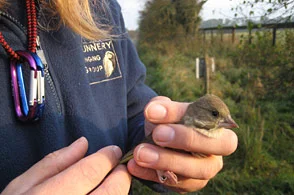Volunteers help the British Trust For Ornithology (B.T.O.) to amass the data used to compile a nationwide survey of bird populations
Conservation being the name of the game, we have our fingers in all sorts of preservation pies here at the Suffolk Owl Sanctuary. One of our very important, annual roles is to assist Brian Thompson and his team from the BTO (British Trust for Ornithology) to keep tabs on the number of songbirds on the S.O.S site. The BTO bird-ringing scheme is a nationwide operation with over 2,700 trained volunteers ringing birds in both Britain and Ireland every year. The ringing of birds is extremely important as it can give the Trust vital information on things such as the increase and decrease of populations and the movements of different species. Although the number of birds ringed on a specific site such as that of the Suffolk Owl Sanctuary represents only a tiny fraction of those recorded, even the smallest details help the BTO to build up an overall picture of how our British songbirds are faring in the wild.
In 2010 the annual total of birds recorded at the Sanctuary was 155. The total for 2011 was 95, not for any reason more untoward than that Brian and his team weren’t able to visit quite so often last year. Overall, the results were not dissimilar to those of 2010, although there was some variation in the species recorded between the two years. The most common birds documented over the last couple of years were our native Dunnocks, Blackbirds, Blue Tits and, topping the bill, House Sparrows. Several birds on the list in 2010 were not recorded at all last year, including the Collard Dove, Great Spotted Woodpecker, Song Thrush, Long-tailed Tit, Coal Tit, Magpie and Goldfinch. However, each of these birds only featured a couple of times in the 2010 list and their absence could well be accounted for by fewer birds in total being recorded this year. The only noticeable absences were the Little Owl, of which five youngsters were ringed in 2010, but none this year and the Great Tit, which showed a significant reduction from 21 in total in the previous results to just 4 verified in 2011.
Very careful handling of the birds as they are ringed is a prerequisite of the task in hand - for more information on the B.T.O. and its work, click here
There were however a handful of newcomers to add to last year’s total, including one of each of the following: Kestrel, Woodpigeon, Pied/White Wagtail, Whitethroat, Chiffchaff, Linnet and two Bullfinches.
All these statistics will help the BTO to generate information about our wild birds and to pinpoint any conservation issues that arise from the results, so we are very glad to be able to help.
Remember: It’s National Nest Box Week from the 14th to 21st February – you can download our free publication Saving Britain’s Owls here and find out how to provide safe & secure homes for wild birds of the Owl variety!
Concern about feeding wild owls in snowy weather
Recently we received an email from a member of the public who was concerned that the owls in her vicinity might be struggling to find food in the recent bitterly cold weather and snowy conditions and asked if it was a good idea to put out food for them. Our best advice is not to worry. Owls use their superb hearing far more than their sight to locate prey, which they can hear even under a light covering of snow. Also, wild owls are used to eating live prey and are most unlikely to be tempted by raw meat, although local cats and foxes would probably be very appreciative!


